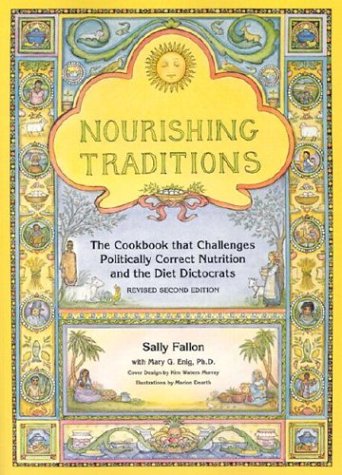When I graduated from high school I became a vegetarian as part of my exploration of eastern religious thought. The friends I made in the college dorms were all vegetarians and we had lots of good years learning to cook, exploring vegetarian cuisine and hosting lots of dinner parties. I learned to make Thai yellow curry, to enjoy whole grains like kasha and bulgar and how to cook spaghetti sauce for a party of 18.
I was never a very "good" vegetarian, though. I would get drunk and eat summer sausage, or get sick and "give in" to a can of chicken soup. I missed the flavors of meat, and felt that eating all that brown rice and tofu couldn't be the be all and end all of nutrition. Sometime during my
 junior year in college I found the book Nourishing Traditions by Sally Fallon at the health food store. I went back to the store three or four times to sit in their cafe and read the book because I didn't have the money to buy it.
junior year in college I found the book Nourishing Traditions by Sally Fallon at the health food store. I went back to the store three or four times to sit in their cafe and read the book because I didn't have the money to buy it.The principles laid out in that book seemed to make so much sense to me. Sally Fallon and her co-author Mary Enig use the work of researchers like Weston A. Price and Francis Pottenger to lay out a healthy, traditional-type diet for modern Americans. Price studied the diets of groups who had never eaten "modern" food in the 1930s and discovered key components of all traditional diets. Pottenger conducted research on the effects of nutrient deficiency on health and disease. Both concluded that high quality meat, saturated fats, vitamin rich dairy and/or seafood along with nutritious vegetable matter comprised the most beneficial diet for humans. It simply made sense to me, despite my years of vegetarianism. Meat, fat, and dairy are high octane fuels, vegetables and grains, despite their many benefits, are mostly fiber and carbs.
During the next year I moved more and more away from vegetarianism. I continued to eat my brown rice but chose not to eat tofu anymore. Eventually I quit the ruse all together. I claimed that I was "giving up vegetarianism to become a hedonist". It was another year b
 efore I had my own kitchen to cook in how I wanted, but I certainly started down the path of hedonism that first summer. Hamburgers and fried chicken never tasted so good!
efore I had my own kitchen to cook in how I wanted, but I certainly started down the path of hedonism that first summer. Hamburgers and fried chicken never tasted so good!In the years since then I have learned more and practiced more cooking a traditional diet. I am still a long way off from an "ideal" diet, if there even is such a thing, but I like how I feel, I like what I eat, and I think it is as good as I can do right now. This blog will be an occasional foray into what's going on in my kitchen. I hope to post recipes, musings and goings on. I'll also show off some of my other favorite real food bloggers, 'cause there are a lot of them out there.
Happy eating, and go drink some cream!
I confess, I ready this quickly. I need to do some thinking and maybe come back are re read your post.
ReplyDeleteHey Alyss! Good for you! This is very cool, and you're just the perfect person to write a food blog.
ReplyDelete-Blair
Thaanks for this blog post
ReplyDelete